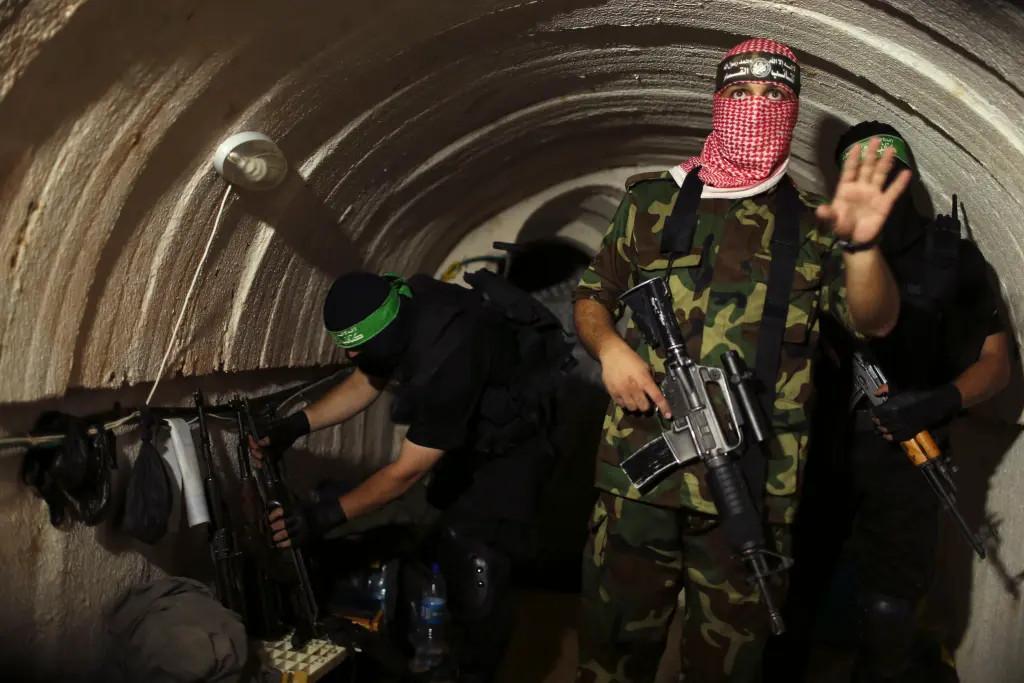
What we know about Hamas’ 300-mile tunnel system below Gaza
As Israel continues its advancements in northern Gaza, its Defense Forces have vowed to destroy Hamas’ 300-mile tunnel system — the key transport route for the terrorist group.
Known as the Gaza Metro, the tunnel system lies beneath the Palestinian enclave with myriad entrances and exits in schools, hospitals, mosques and civilian homes.
Several gateways are even believed to be in al-Shifa Hospital, Gaza’s main medical center that is also serving as a shelter for displaced Palestinians, a claim Hamas has denied.
The tunnels are an extensive blind spot for Israel, where Hamas fighters can engage in guerrilla warfare and avoid Israeli airstrikes in shafts that go as deep as 130 feet.
The tunnels are also the ideal route to transport weapons and hostages.
Israel’s last big assault into the underground system came in 2014, during Operation Protective Edge when IDF soldiers fought with Hamas for 50 days while surveying the subterranean network.
Since then, units within the IDF have undergone extensive training to fight in the tight tunnels, but experts fear Hamas still has the upper hand in an underground battlefield likely riddled with traps.
Subterranean defense
The existence of the vast tunnels running underneath Gaza was first reported in 2006, and they were primarily used as a means to bypass Israel’s blockade after Hamas was elected to power.
The tunnels aimed to smuggle food and other necessities to the more than 2 million Palestinians living in the enclave, but Hamas quickly took control of the passages and began expanding them over the years for military purposes.
The IDF has previously taken journalists on tours of tunnels it has captured, showing them to be sophisticated structures with concrete walls and electricity while being wide enough for carts to travel in, the Washington Post reported.
However, to the uninitiated, traveling through the tunnels can be claustrophobic as many passageways are only a few feet tall and lack any lighting.
In these tight spaces, veteran Hamas fighters would have the upper hand against IDF soldiers, who will likely encounter an onslaught of boobytraps first.
Near the start of the war against Hamas, Bruce Hoffman, an expert with the Council on Foreign Relations, warned about the dangers the tunnels pose, noting they are likely where the 239 hostages are being kept by Hamas.
“These places and perhaps even the hostages themselves will likely be laden with traps,” Hoffman wrote in a grave briefing. “This is a challenge of a magnitude that has never been faced before.”
Colin P. Clarke, a conflict and terrorism specialist at the Soufan Group, echoed that Israel faces an uphill battle within the “Gaza Metro” tunnel system.
“Any time you are dealing with a subterranean network of tunnels, it becomes extremely complex,” the expert told iNews. “Hamas will have been preparing for an Israel Defense Forces [IDF] ground assault and know these tunnels inside out.
“Some of them are likely to be booby-trapped,” Clarke added. “Preparing to fight in such terrain is incredibly difficult and would require extensive intelligence on what the network of tunnels looks like — which the Israelis may not have.”
What is Israel’s strategy to take out Hamas’ terror tunnels?
During the 2014 conflict, Israel was able to map out several entrances and exits to the Gaza Metro, identifying underground bases housing weapons and combatants.
Dr. Daphné Richemond Barak, a professor at Israel’s Lauder School of Government and an expert in underground warfare, said that since 2014, the IDF has been training on how to conduct subterranean battles in the identified tunnels.
“IDF also used simulators where you put these virtual reality goggles on, which would then take you inside the virtual tunnel,” she told CNN of the intensive training.
Israeli soldiers may also be able to turn the tunnels into a big disadvantage for Hamas by employing a new weapon called “sponge bombs.”
The new bombs consist of chemical compounds that swiftly expand and harden when thrown, allowing Israeli soldiers to seal off passages in the tunnel.
The device would leave Hamas fighters with no escape and allow Israeli commandos to secure safe routes while searching for hostages, according to reports.
Barak added that Israel could also likely attack the tunnels with high-pressure water systems, which “would cause a collapse of the structures of the tunnels.”
It remains unclear which method the IDF is using to take out the terror tunnels, which have been the site of recent ground strikes in northern Gaza where the Israeli military has touted more than 600 Hamas targets neutralized in recent days.
As one mission saw the safe rescue of a captured IDF fighter, the Israeli military reiterated that the key to victory would be the dismantling of the Gaza Metro.
“Destroying Hamas means destroying their tunnel network of terror,” the IDF said in a statement Sunday.
Source » nypost





